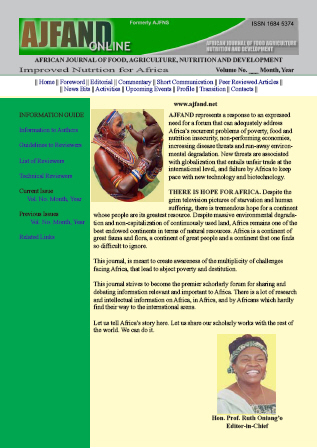
|
African Journal of Food, Agriculture, Nutrition and Development
Rural Outreach Program
ISSN: 1684-5358
EISSN: 1684-5358
Vol. 8, No. 4, 2008, pp. 390-404
|
 Bioline Code: nd08036
Bioline Code: nd08036
Full paper language: English
Document type: Research Article
Document available free of charge
|
|
|
African Journal of Food, Agriculture, Nutrition and Development, Vol. 8, No. 4, 2008, pp. 390-404
| en |
Influence of agricultural biodiversity on dietary diversity of preschool children in Matungu division, Western Kenya
Ekesa, BN; Walingo, MK & Abukutsa-Onyango, MO
Abstract
Agricultural biodiversity encompasses the variety and variability of plants and animals that are necessary for food production and accessibility. Loss of agricultural biodiversity is taking place at a very high rate in Kenya. Many indigenous species that are not only nutritious, but also adapted to harsh conditions are now associated with poverty or backwardness. This profound change has great effect on preschool children in Kenya. Their diets are predominantly based on starchy staples, little or no animal products and few fruits and vegetables thus inadequate in quality and quantity resulting to malnutrition. The main objective of this cross-sectional survey was to determine the influence of agricultural biodiversity on dietary diversity of preschool children in Matungu division, western Kenya. A sample of 144 households with preschool children was drawn from Matungu division using multistage,proportional and systematic random sampling techniques. Structured questionnaires and observation checklists were used for data collection. Agricultural biodiversity was measured by variety of food crops grown, types of animals domesticated for food and food items obtained from natural sources. Dietary diversity was measured by the number of food items across eight food groups with a reference period of 7 days. Data were analyzed using Statistical Package for Social Sciences (SPSS). Frequencies, means and percentages were used to organize, describe and summarize data whereas Pearson's correlation coefficient (r) was used to test for statistical associations between agricultural biodiversity and dietary diversity. Research findings showed that households grew an average of three types of food crops kept two varieties of animals for food and got two food items from natural sources. Preschool children had consumed on average 13 varieties of foods in the one-week preceding the study. The findings also revealed a positive and strong relationship between agricultural biodiversity and dietary diversity (r= 0.704) indicating that 50% of the changes in dietary intake could be attributed to changes in agricultural biodiversity. Therefore, increased agricultural biodiversity enhances dietary diversity of preschool children leading to improvement in their nutrition and health status. It was therefore recommended that the Ministry of Agriculture and related organizations reinforce extension services (training/education on agricultural biodiversity and sustainable utilization of neglected indigenous food sources) to rural populations especially women.
Keywords
agricultural biodiversity, dietary diversity, children
|
| |
© Copyright 2008 - Rural Outreach Program
Alternative site location: http://www.ajfand.net/
|
|
